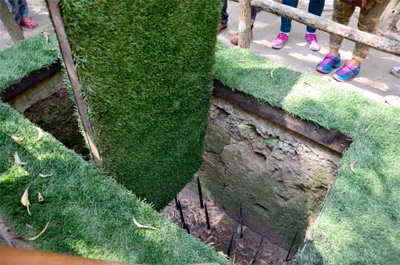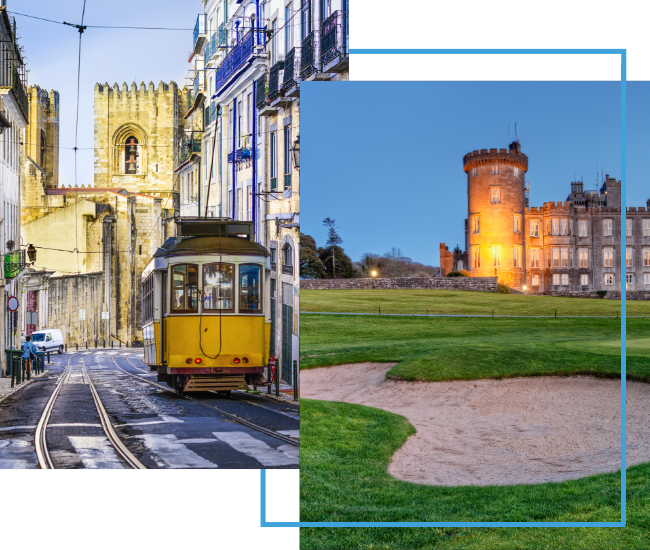VIETNAM’S CU CHI TUNNELS attest to the extraordinary resourcefulness and resilience of a group of Southern Vietnamese people, known as the Viet Cong, during their struggle to fight and survive the Vietnam War. Located just outside Ho Chi Minh City in the region of Cu Chi, the tunnels enabled the Viet Cong to survive underground during this historic conflict which broke out in 1954, pitting the Communist Viet Minh party of North Vietnam and its southern allies, known as the Viet Cong, against the non- Communist faction of South Vietnam and its main ally, the United States.
Two sites — Ben Dinh and Ben Duoc — allow visitors to view and even crawl through the tunnels, which the Communist forces built over the course of 20 years. To view either one, the easiest method is to have your hotel arrange a tour out of Ho Chi Minh City. You can be picked up at your hotel, taken to the site and returned later that day — the tunnels lie about 20 and 30 miles outside of Ho Chi Minh City. You’ll want to wear clothes you don’t mind getting dirty.

Rifle exposed in the Cu Chi tunnel park © MIRKO VITALI | DREAMSTIME.COM
Because the tunnels of Ben Dinh lie closer to Ho Chi Minh City, they’re the most popular to visit. Your guided tour begins with a short film explaining the historical background of the tunnels. It’s worth knowing before you get down on your hands and knees that the original region of Cu Chi was thick with rubber plantations supplying a French tire company. Apparently, the area’s first tunnels were dug in the 1940s by the anti-colonial Viet Minh to store their arms during their struggle for independence from the French. The Viet Cong greatly expanded the network, easily dug from the area’s compacted red clay. However, as you’ll learn from your guide (or supplementary reading), all the ceilings of the tunnels had to be reinforced, ideally with wood. But since American bombing of the area reduced the availability of timber, the Viet Cong ended up using iron fence posts from enemy bases.
Within the multistory tunnels — some were four levels deep — the Viet Cong lived for weeks, even years. The tunnels had sleeping quarters, meeting rooms, schools, kitchens, wells and latrines, as well as makeshift hospitals. Surgeons operated by torch light using rudimentary instruments, and a patient’s own blood was deposited in a bottle and then pumped back into the body using a bicycle pump and rubber hosing.
Although the tunnels had vent shafts to disperse cooking smoke, not surprisingly the passages could become extremely hot and foul-smelling. Inhabitants also had to fight off bats, snakes, scorpions, centipedes and fire ants. The Viet Cong used some of these creatures as weapons, setting up boxes of scorpions and hollow bamboo sticks filled with vipers in areas of the tunnels the enemy (mainly American forces) might enter. Flooding in the tunnels was a constant risk, as was disease, particularly malaria. Hidden trap doors provided release points for the inhabitants, who would leave the tunnels to fight and hunt for food (mainly roots and leaves, since American chemical weapons and bombs destroyed most of the Viet Cong’s rice paddies and fruit crops). After an attack, the Vietnamese fighters disappeared into the tunnels, eluding their American enemy. The Viet Cong not only used the tunnels as living quarters but also as hideouts and routes to transport communications and supplies. For tunnel inhabitants who stayed underground for extended amounts of time, the darkness was so intense, when they finally exited they suffered temporary blindness.

A booby trap with bamboo spikes at the tunnels © TUAYAI | DREAMSTIME.COM
American soldiers knew about the tunnels and tried to flush out the enemy. In addition to using bulldozers and defoliant sprays, American soldiers crawled down into the tunnels with hand grenades or gas bombs. The tunnels, however, were often so low and narrow American soldiers could not get down them, let alone scurry through them. Indeed, as you make your way through the labyrinth of dirt passageways (many of which have been widened to accommodate the larger girth of visiting tourists), you’ll sense immediately how dark, dirty and claustrophobic they feel, even after only 10 minutes. As you might imagine, the tunnels open to visitors only represent a fraction of the 155-mile-long and 30-mile-wide network.
More than 3 million people perished during the war; half were Vietnamese civilians. In 1973 President Richard Nixon ordered the withdrawal of U.S. troops from Vietnam. In 1975 the war ended when Communist forces took control of Saigon (now Ho Chi Minh City) and renamed the country the Socialist Republic of Vietnam the following year.
Years after the war, the Vietnamese government created a war memorial park that included the Cu Chi tunnels, where more than 45,000 Vietnamese were said to have died. In 1982 the Vietnam Veterans Memorial opened to the public in Washington, D.C., inscribed with the 57,939 names of American armed forces killed or missing during the war.
Info to Go
Many airlines fly daily from the United States to Vietnam, including Korean Air, Cathay Pacific and American Airlines. Ho Chi Minh City’s Tan Son Nhat Airport (SGN) lies approximately 20 minutes by car outside the city center, and regulated taxis remain the most reliable, convenient and popular form of transportation to get you to your hotel. Alternatively, you can arrange in advance with your hotel to have a car meet you at the airport.
Read This Next
All Reads on This Topic
Read Them All

Introducing
FX Excursions
FX Excursions offers the chance for once-in-a-lifetime experiences in destinations around the world.
#globility
Insta FeedApril 2025
Apr 9, 2025Find Inner Peace in India, the Birthplace of Yoga
How far would you travel in pursuit of inner peace? Though the wellness industry has grown in popularity for quite a while, he business skyrocketed post-pandemic, with more and more travelers booking yoga retreats in the name of serenity, spirituality and, of course, self-care. When I decided it was zen I sought, I figured I should travel to its very birthplace: India. Though the idea of traveling in India initially felt more exciting than relaxing, I found the contrast between the bustling activity outside and the quiet reflection of my yoga practice to be an intoxicating combination.
Sponsored Content
Royal Air Maroc Marks Five Years with oneworld: Strengthening Connectivity Between USA and Africa and Expanding Global Reach
Royal Air Maroc proudly enters its fifth year as a member of the prestigious oneworld alliance. Since joining in April 2020, RAM has demonstrated resilience during the COVID-19 pandemic, emerging as a dynamic airline that enhanced its digital services and expanded its network. The airline plans to grow its fleet to 200 aircraft by 2037, reinforcing its global presence.
Daily
Apr 9, 2025Resort in Riviera Maya, Mexico, Announces Chef-Led Series
It’s spring and a delicious new series of culinary experiences is planned at Etéreo, Auberge Resorts Collection in Riviera Maya, Mexico. Dubbed Origins of Mexico, this new, chef-led dining series is immersive in nature and lusciously focuses on regional flavors, local traditions and culinary practices from across Mexico.
April 2025
Apr 9, 2025Relax and Recharge in Blissful Bali
Known as the Island of Gods, Bali boasts more than 20,000 temples; two active volcanoes; some 2,000 species of fish and other sea life; a thriving arts scene; and an abundance of spa and wellness resorts. Its distinct religion, culture and natural setting have drawn travelers from around the globe for decades, many seeking a slice of serenity. Today Bali draws everyone from backpackers to business travelers and digital nomads to celebrities. David Bowie even dictated his ashes be scattered around Bali.
Sponsored Content
Find Your Perfect Escape with Paradisus by Meliá — More Than Just All-Inclusive
Luxury travel today is about more than just beautiful accommodations — it’s about experiencing the destination. Paradisus by Meliá takes traditional all-inclusive resorts to the next level by offering indulgence with immersion, experiences and authenticity. Each resort is shaped by its location, local flavors and curated Destination Inclusive® experiences that bring you closer to the heart of the destination.
Daily
Apr 9, 2025Raffles Hotels & Resorts Comes to Lake Como
Raffles Hotels & Resorts recently announced plans for its Italian debut. The luxury brand will open Raffles Lake Como in 2027. The opening marks the first Raffles property in Italy and its fifth in Europe.
Almyra Restaurant Review
eFlyer Reviews
Apr 9, 2025Exclusive April Promotions from Viking
eFlyer Deals
Apr 9, 2025eFlyer Deals
Apr 9, 2025Miami’s THesis Hotel Debuts Wellness Offer
You can now earn an “education” in relaxation and rejuvenation at THesis Hotel Miami with its new Thesis Degree in Wellness offer. Designed to nurture overall wellbeing, this was crafted in collaboration with neighboring Hydrology Wellness Center & Spa to give guests:
Sponsored Content
A Summer Sojourn Along Europe’s Rivers with AmaWaterways
This summer, elevate your vacation experience with award-winning AmaWaterways. Offering a seamless blend of unparalleled luxury, authentic cultural experiences and unrivaled service, AmaWaterways cruises are the perfect way to uncover the heart of Europe during the sunniest season with itineraries that glide along the continent’s most iconic rivers, including the Danube, the Rhine, the Seine and the Douro.
eFlyer Lead
Apr 9, 2025Carbon Monoxide Poisoning in Hotels, Rentals: How to Stay Safe
On March 21, Miller Gardner, the 14-year-old son of former New York Yankees outfielder Brett Gardner, was found dead in a hotel room on a family vacation in Costa Rica. A few days after the tragedy, the Judicial Investigation Agency ruled his death as carbon monoxide poisoning. The family had been staying at Arenas Del Mar Beachfront & Rainforest Resort, a 5-star property in the Puntarenas Province. On April 1, a spokesperson for the resort claimed the carbon monoxide levels in the family’s room were not present nor deadly.
ShareThis